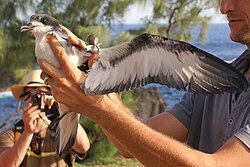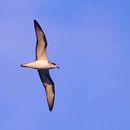Biology
(
Anglèis
)
fornì da Arkive
Barau's petrels are migratory birds, leaving the waters around Réunion between April and June, and heading for the open Indian Ocean, where they spend the winter. Here, they are often seen feeding in large flocks with many other sea birds. They feed on small, schooling fish, seizing them from the surface or plunging into the water to snatch their prey (3). In September, the petrels return to Réunion Island, and in November, females lay a single egg in a nesting burrow high up on the remote mountain cliffs, which hatches between the end of December and the beginning of January (3).
Conservation
(
Anglèis
)
fornì da Arkive
A campaign was implemented to raise public awareness of the effect of urban lighting on petrels, and to rescue as many grounded birds as possible. Each year, many Barau's petrels are now found and rescued, with increasing success; in 2001, 787 petrels were rescued (2) (5). There are also proposals to reduce light pollution on the island (2). Increasing tourism suggests that conservation efforts should include strict regulation of human activities near the colonies, particularly hiking and mountaineering. Efforts should also be made to eradicate potential predators from the nesting colonies (5).
Description
(
Anglèis
)
fornì da Arkive
Discovered as recently as 1963, Barau's petrel remains fairly unknown due to its inaccessible and remote breeding habitat on just a single island in the Indian Ocean (3). Barau's petrel is a medium-sized petrel with greyish-brown plumage on top and white underparts. A fairly distinct 'M' shaped marking extends across the back and wings, and when in flight, the dark edges of the underside of the wing are visible (2). As with other petrels, its large wingspan is an adaptation for continuous flight over the ocean, and its sharp bill with a hooked tip is perfect for dealing with slippery fish prey (4).
Habitat
(
Anglèis
)
fornì da Arkive
The nesting sites of Barau's petrel are in elfin forests on inland mountain cliffs, between 2,000 and 2,800 metres above sea level (3) (5). It appears to require a thick, undisturbed humus layer in which to burrow (5).
Range
(
Anglèis
)
fornì da Arkive
Barau's petrels nest on Réunion Island in the Indian Ocean (3). When not breeding, they occur in the western part of the tropical south Indian Ocean, and have also been sighted in the southern Arabian Sea, between the Maldives and Sumatra, and in the Cocos-Keeling Island region (3).
Status
(
Anglèis
)
fornì da Arkive
Classified as Endangered (EN) on the IUCN Red List 2007 (1).
Threats
(
Anglèis
)
fornì da Arkive
Mammals introduced to the island of Réunion are believed to be impacting the Baraus' petrel; eggs and chicks are preyed on by rats and cats, and goats may trample burrows and disturb suitable nesting habitat (2) (5). However, the extent to which this threatens the species is not clear; the remote, rugged habitat of breeding colonies may have limited access for these alien species (3). In the last 50 or so years, urban development on the island has led to a dramatic increase in the number and intensity of streetlights and other bright lights which confuse large numbers of fledging Barau's petrels on their way to the sea at night. Grounded birds are then usually killed by vehicles or predated by dogs and cats. An additional potential threat comes from the increasing pressure for tourism to remote areas, which could result in human disturbance at the nesting colonies (5).
Zoologger: 'Werewolf birds' hook up by the full moon
(
Anglèis
)
fornì da EOL authors
The Barau's petrel is one of a handful of tropical birds that uses the moon as a kind of alarm clock...
read more
Barau's petrel
(
Anglèis
)
fornì da wikipedia EN
Barau's petrel (Pterodroma baraui) is a medium-sized gadfly petrel from the family Procellariidae. Its main breeding site is the island of Réunion in the Indian Ocean.
Etymology
The name commemorates Armand Barau, an agricultural engineer and ornithologist from the French territory of Réunion in the Indian Ocean. It is one of the most recently discovered species of seabird and was only described in 1964, although it was known to local people prior to that.
Description
Barau's petrel is around 40 cm long, and has white undersides and forehead. Its bill is black and its upper parts are dark, with a moderately distinct "M" pattern across the wings and back.
Distribution and habitat
Barau's petrel ranges across the Indian Ocean from Réunion to Western Australia and Indonesia. With the exception of a single nest found on the island of Rodrigues the bulk of the population is thought to nest on Réunion.
Behaviour
Feeding
The petrels are highly pelagic at sea, preying on small fish (10 cm) by surface-seizing and plunge diving. They will associate with other species while feeding.
Breeding
Their colonies are unusual in being far inland and at high elevations; they dig burrows under the forest at around 2,400-2,700m above sea level. The breeding biology of the species has not been studied but it is inferred that they have a 55-day incubation period and take around 100–120 days to fledge a chick. Unlike most burrow nesting procellariids, Barau's petrels begin to return to their colonies diurnally, returning in the late afternoon and riding the thermal updrafts to conserve energy. The chicks fledge between November and February. Sites which have been identified by BirdLife International as being important for the conservation of the species include the Grand Bénard – Tapcal and Piton des Neiges – Gros Morne Important Bird Areas (IBAs) on Réunion where breeding colonies exist.[2]
Status and conservation

Release of a rescued fledgling
Barau's petrel is considered to be an endangered species. It has a highly restricted breeding range and has suffered hunting pressure in the past. While the shooting of the species has now been stopped, and the population seems to have recovered, it is currently threatened by introduced species and light pollution. Young birds, particularly fledglings, are disorientated by artificial lights such as streetlights or the floodlights of sporting venues, which they mistake for bioluminescent squid, and lead them to fail reach the sea. It is estimated that as much as 40% of each breeding season's fledglings get confused in this fashion. Conservation organisations work with local people to catch disorientated chicks and release them back at sea, a program that is thought to rescue most of the lost chicks. Measures are also underway to reduce light pollution by shielding light sources so that they don't attract young birds, a method that has been used to help Newell's shearwaters in Hawaii.
References
- Brooke, M. (2004). Albatrosses And Petrels Across The World Oxford University Press, Oxford, UK ISBN 0-19-850125-0
- Le Corre, M., Ollivier, A., Ribes, S., Jouventin, P., (2002) "Light-induced mortality of petrels: a 4-year study from Réunion Island (Indian Ocean)" Biological Conservation 105: 93–102 [1]
- licensa
- cc-by-sa-3.0
- drit d'autor
- Wikipedia authors and editors
Barau's petrel: Brief Summary
(
Anglèis
)
fornì da wikipedia EN
Barau's petrel (Pterodroma baraui) is a medium-sized gadfly petrel from the family Procellariidae. Its main breeding site is the island of Réunion in the Indian Ocean.
- licensa
- cc-by-sa-3.0
- drit d'autor
- Wikipedia authors and editors
Habitat
(
Anglèis
)
fornì da World Register of Marine Species
breeding on Mascarene isl.
van der Land, J. (ed). (2008). UNESCO-IOC Register of Marine Organisms (URMO).
- licensa
- cc-by-4.0
- drit d'autor
- WoRMS Editorial Board

